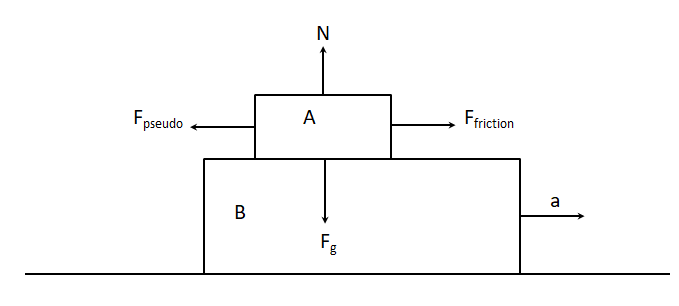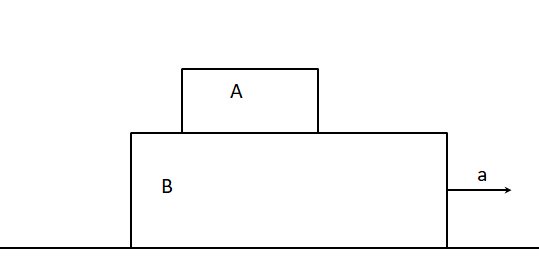Answer
401.4k+ views
Hint: To solve this kind of problem, the first step is always making the free body diagram. The force body diagram is to be made for body A. The frictional force is given by \[\mu N\]. Comparing the forces acting against each other will solve the problem.
Step by step solution:
Let’s start by making a free body diagram of the problem.

Here, we only need to make the free body diagram for block A, since the problem needs us to only find the coefficient of friction \[(\mu )\], between the block A and the plank B.
Let the mass of the block A be m. The acceleration due to gravity (g), acting downwards on the block. Hence, the downward force is ${{F}_{g}}=mg$. The normal force acting on the block A acts perpendicular to the block A, hence, vertically opposite to the force \[{{F}_{g}}\]. The maximum possible acceleration of plank B is a, that is, $a=2m{{s}^{-2}}.$ This causes a pseudo backward force on the block A. Hence, in the free body diagram, the pseudo force \[{{F}_{pseudo}}\] acts on the block A towards the opposite direction of the movement of plank B. This causes the frictional force to act in the opposite direction to that of the movement of pseudo force. Hence, frictional force $({{F}_{friction}})$ acts towards the right of block A.
Now equating the forces along the vertical axis, we get, N=mg. Now, upon equating the forces along the horizontal axis we get, \[{{F}_{pseudo}}={{F}_{friction}}\]. We know that the frictional force is given by, \[{{F}_{friction}}=\mu N\Rightarrow {{F}_{friction}}=mg\mu \]. The pseudo force acting on the block A is, \[{{F}_{pseudo}}=ma=2m\]. Equating these two we get, $mg\mu =2m\Rightarrow \mu g=2\Rightarrow \mu =\dfrac{2}{g}$. Hence, the coefficient of friction between the block A and the plank B is $\mu =\dfrac{2}{g}$.
Note:
In this problem, the pseudo force can be thought of as the inertial force. To picture it, let’s consider the example of a bus journey. When we are standing in a bus, as soon as the bus starts to move with a slightly large acceleration, we feel a jerk pushing us backward. This backward jerk is known as the pseudo force acting on the block A.
Step by step solution:
Let’s start by making a free body diagram of the problem.

Here, we only need to make the free body diagram for block A, since the problem needs us to only find the coefficient of friction \[(\mu )\], between the block A and the plank B.
Let the mass of the block A be m. The acceleration due to gravity (g), acting downwards on the block. Hence, the downward force is ${{F}_{g}}=mg$. The normal force acting on the block A acts perpendicular to the block A, hence, vertically opposite to the force \[{{F}_{g}}\]. The maximum possible acceleration of plank B is a, that is, $a=2m{{s}^{-2}}.$ This causes a pseudo backward force on the block A. Hence, in the free body diagram, the pseudo force \[{{F}_{pseudo}}\] acts on the block A towards the opposite direction of the movement of plank B. This causes the frictional force to act in the opposite direction to that of the movement of pseudo force. Hence, frictional force $({{F}_{friction}})$ acts towards the right of block A.
Now equating the forces along the vertical axis, we get, N=mg. Now, upon equating the forces along the horizontal axis we get, \[{{F}_{pseudo}}={{F}_{friction}}\]. We know that the frictional force is given by, \[{{F}_{friction}}=\mu N\Rightarrow {{F}_{friction}}=mg\mu \]. The pseudo force acting on the block A is, \[{{F}_{pseudo}}=ma=2m\]. Equating these two we get, $mg\mu =2m\Rightarrow \mu g=2\Rightarrow \mu =\dfrac{2}{g}$. Hence, the coefficient of friction between the block A and the plank B is $\mu =\dfrac{2}{g}$.
Note:
In this problem, the pseudo force can be thought of as the inertial force. To picture it, let’s consider the example of a bus journey. When we are standing in a bus, as soon as the bus starts to move with a slightly large acceleration, we feel a jerk pushing us backward. This backward jerk is known as the pseudo force acting on the block A.
Recently Updated Pages
Basicity of sulphurous acid and sulphuric acid are

Assertion The resistivity of a semiconductor increases class 13 physics CBSE

Three beakers labelled as A B and C each containing 25 mL of water were taken A small amount of NaOH anhydrous CuSO4 and NaCl were added to the beakers A B and C respectively It was observed that there was an increase in the temperature of the solutions contained in beakers A and B whereas in case of beaker C the temperature of the solution falls Which one of the following statements isarecorrect i In beakers A and B exothermic process has occurred ii In beakers A and B endothermic process has occurred iii In beaker C exothermic process has occurred iv In beaker C endothermic process has occurred

The branch of science which deals with nature and natural class 10 physics CBSE

What is the stopping potential when the metal with class 12 physics JEE_Main

The momentum of a photon is 2 times 10 16gm cmsec Its class 12 physics JEE_Main

Trending doubts
Difference between Prokaryotic cell and Eukaryotic class 11 biology CBSE

Difference Between Plant Cell and Animal Cell

Fill the blanks with the suitable prepositions 1 The class 9 english CBSE

Change the following sentences into negative and interrogative class 10 english CBSE

Give 10 examples for herbs , shrubs , climbers , creepers

What organs are located on the left side of your body class 11 biology CBSE

Write an application to the principal requesting five class 10 english CBSE

What is the type of food and mode of feeding of the class 11 biology CBSE

Name 10 Living and Non living things class 9 biology CBSE




